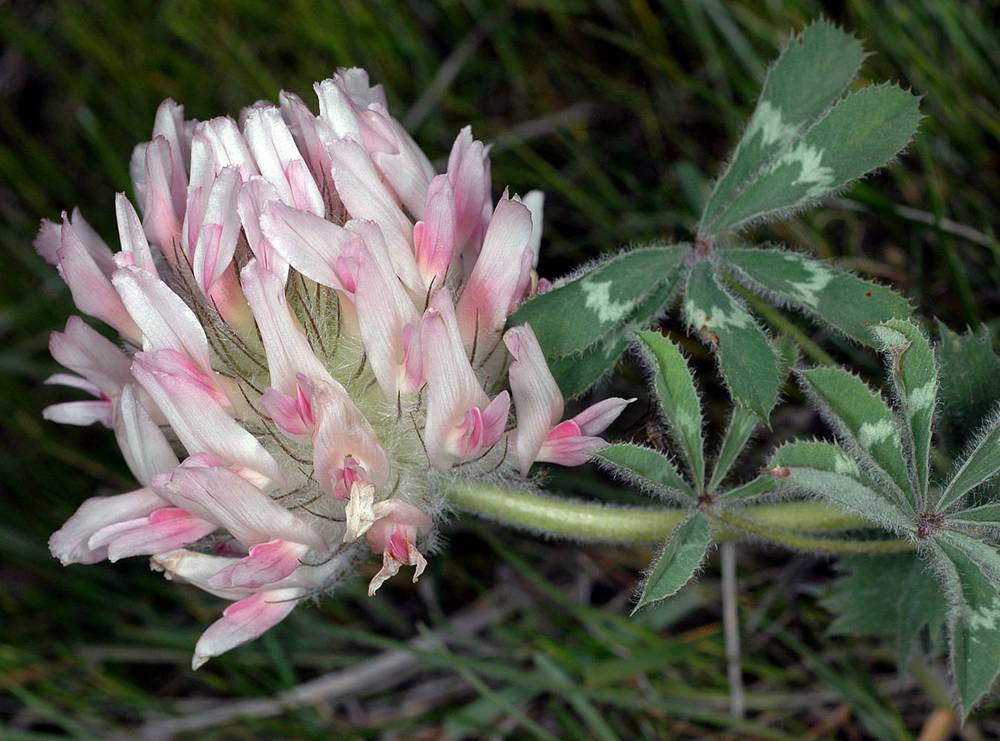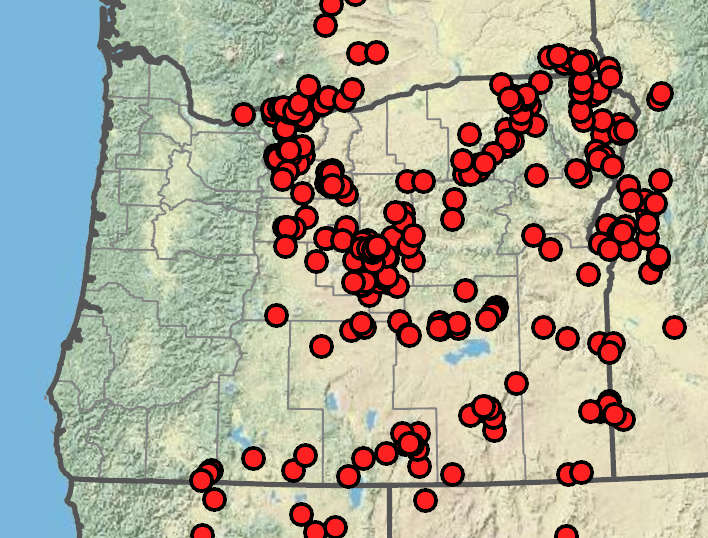Trifolium macrocephalum
Trifolium hirtum
big-headed clover, largehead clover
rose clover
palmate;
leaflets (5)7–9, broadly to narrowly obovate, often folded, 10–27 × 4–11 mm, bases cuneate;
margins serrulate or irregularly lobed;
veins thickened, especially distally;
tips rounded or truncate, apiculate;
surfaces abaxially villous, adaxially sparsely villous to glabrate;
petioles 10–140 mm;
petiolules 0.9–1.2 mm;
stipules ovate, obovate, or oblong, 10–30 mm;
margins entire.
pinnate;
leaflets 3, obovate to oblong, 8–25 × 5–13 mm, bases cuneate;
margins denticulate distally;
veins prominent, closely-spaced;
tips rounded;
surfaces densely spreading-hairy;
petioles 5–50 mm;
petiolules ~0.5 mm;
stipules lanceolate-ovate, 8–18 mm;
margins entire;
tips long-setaceous.
terminal, 20–32-flowered, globose or ovoid-ellipsoidal, 25–80 × 30–70 mm;
involucres absent;
bracteoles broadly ovate, membranous; ? 0.5 mm, truncate.
terminal on branches, 10–50-flowered, globose or ovoid, 15–25 × 15–25 mm, disarticulating at maturity into fruiting calyces;
involucres enlarged stipules;
bracteoles absent.
20–80 mm.
absent.
erect, 1–1.5 mm.
absent.
20–30 mm;
calyces campanulate, 10–22 mm, villous;
veins 10–15;
tubes 2.5–4 mm;
lobes subulate, subequal, 2–4 × tube length, plumose;
orifices open;
corollas 20–28 mm, white; creamy white, or pinkish;
banners ovate or oblong, 20–28 × 10–13 mm;
tips rounded or slightly emarginate;
keel petals deep pink.
10–17 mm;
calyces campanulate, 7–11 mm, pilose;
veins 20;
tubes 2–5 mm;
lobes subequal; abaxial slightly longer;
orifices open, pilose;
corollas 10–14 mm, pink to purplish red;
banners lanceolate, 10–14 × 1–2 mm;
tips acute-acuminate.
longitudinally dehiscent; ovoid, 4–5 mm; ? calyces.
transversely dehiscent; ovoid, 2–3 mm; ? calyces; leathery distally.
1–2; mitten-shaped to ellipsoid, 2.5–3 mm, yellow or reddish; smooth.
1, globose-ellipsoid, 1.5–2 mm, tan or brown; smooth; glossy.
=32, 48.
=10.
Trifolium macrocephalum
Trifolium hirtum
Rocky places, hard, compacted clay gumbo, lava beds, sage-covered slopes. Flowering Apr–Jul. 0–2200 m. BR, BW, Col, ECas, Lava, Owy. CA, ID, NV, WA. Native.
Trifolium macrocephalum has the largest inflorescences of any species in the genus. The name T. megacephalum is an illegitimate replacement name for Lupinaster macrocephalum.
Fields, roadsides. Flowering Apr–Jun. 50–800 m. Sisk, WV. CA; southeastern US; Africa, Asia, Europe. Exotic.
Trifolium hirtum is native to the Mediterranean region. It was first cultivated in California in the 1940s and is used as a forage plant and as a nitrogen source in roadside grass plantings (Love 1985).
Michael Vincent
Michael Vincent
- Local floras:
CA,
OR,
WA
- Local Web sites:
CalFlora,
CalPhotos,
Flora NW,
PNW Herbaria
WildflowerSearch
iNaturalist (observations)
USDA Plants Database
- LBJ Wildflower Center
- SEINet
- Plants of the World Online
- Encyclopedia of Life
- Wikipedia
- Google Image Search





